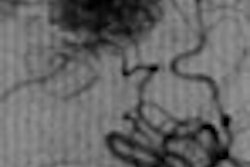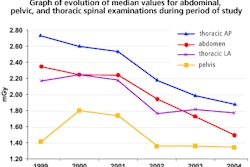This article originally appeared in the American Journal of Roentgenology, written by Dr. Robert Harris from the departments of radiology and obstetrics/gynecology at Dartmouth Medical School in Lebanon, NH.

The list seems to be endless. More and more physicians are calling for healthcare reform, and we, as radiologists, should add our collective voices to the public outcry. We need to become active in health policy discussions. It is only a matter of time, perhaps two years or five years, certainly by 10 years, until healthcare reform will take shape. Radiologists as specialists need to be proactive and become an integral part in the planning of healthcare reform -- reform that will accommodate a several-tiered system that will still allow choice in providers and types of coverage for all citizens, with increased coverage features for those able to afford it.
This policy brief will outline the basic problem, how radiologists contribute to it, and some possible solutions. To illustrate the basic problem, here are a few meaningful statistics from various governmental sources:
- Approximately 16 million Americans are seriously underinsured for medical health coverage.
- Nearly half of all Americans who file for bankruptcy do so because of medical expenses.
- During the past five years, health insurance premiums for U.S. workers have increased 73%, whereas wages have grown by only 15%.
- The U.S. ranks only 15th among developed countries in key health statistics despite the highest per capita health spending. Clearly, we have a problem, and as radiologists, we contribute to the dilemma. For example, I believe (as most radiologists I have spoken to do) that we add little or no value (defined as a "zero-sum competition" by the Harvard Business Review [June 2004, Vol. 82:6 pp. 65-76]) to medical care by interpreting, for example, the fourth chest radiograph in two hours on a long-term ICU patient or by suggesting an additional imaging test when it will not change the patient's diagnosis or management. Do we really need CT examinations for oncology patients at two-month intervals for protocol purposes?
I work at an academic medical center where we perform a large number of second interpretations of outside studies, primarily to get a report into our electronic medical record system. I find (from personal experience) that 90% to 95% of these second interpretations add nothing significant to patient care. These second interpretations add to medical costs (the third-party payor is billed again for the second interpretation) with little to no added value to the patient or physician.
So what are the solutions? There are several steps we can take to address the current unjust system. First, the organizations that represent radiology should establish a task force to look at methods of reducing radiologists' errors and "no-value-added radiology," so that we can devote our limited resources to areas in which we do make a difference and participate in the eventual national healthcare insurance solution before it becomes mandated to us. Just as the American College of Radiology (ACR) was the vanguard for the relative value units (RVUs) system some 10 years ago, we can be leaders in this effort and preserve our needed presence at the healthcare reform bargaining table.
Second, reforming the healthcare system must be looked on as a "war" on inefficiency and waste, and it is likely that all physicians will have to sacrifice a little economically to fund increased healthcare access. I suggest that all radiologists donate a small portion of their income (let's say, for example, 10% for private practitioners and 5% for academicians) to help establish a universal health access pool. This contribution could be cut in half for those who are five years or less past training.
Although this sacrifice will be painful to all of us, it will be seen as a tremendous goodwill gesture and would elevate organized radiology's status in the U.S. Congress as a generous and justice-minded constituency, not just a self-serving lobby. I hope and believe that, once this plan is initiated, other medical specialties would soon join us in making similar contributions. I am hopeful this essay will generate some response from readers -- be they critical or supportive. At the very least, let us open discussion on this issue.
Recently, on a physicians' salary Web site I read that a radiologist's salary in the Northeast has a mean range of $350,000 to $460,000, whereas a family practitioner's income in the same region ranges from $135,000 to $177,000. This salary discrepancy seems unjust and unfair, and the U.S. reimbursement system seems obviously out of whack. I, as most of us, would be most displeased if the financial numbers were reversed.
I do think that we deserve fair compensation for our work. We also deserve, and have earned, the right to perform imaging studies in areas for which we are eminently trained above all other specialties. Clinicians should see patients in their offices or practices and, in most cases, leave the imaging to the imaging experts -- radiologists. One way to win the turf war, which seems never ending, is to reduce the financial incentives for imaging. What we might lose in per-case reimbursement, we could counterbalance with the increased volumes and lack of interspecialty competition that aggravate our stresses.
We need to get on board and start to convince our recalcitrant radiology community members, and other specialties, that there is genuine need and demand for a national healthcare policy reform. The other major players in this arena -- the drug companies, biotechnology firms, and health insurance companies -- will certainly fight this attempt as they have done in the past. For this reason, physicians must stand up for what is right and equitable, and we can eventually win. Remember the Hippocratic oath we all took as newly graduated physicians? To summarize, it was to serve all the population for all their healthcare needs and, first, to do no harm. Now, we as a profession must take the first step toward an equitable and just universal healthcare system.
By Dr. Robert D. Harris
AuntMinnie.com contributing writer
May 1, 2007
This article originally appeared in the American Journal of Roentgenology (March 2007, Vol. 188:3, pp. 617-618). Reprinted by permission of the ARRS.
The opinions expressed in this policy brief are those of Dr. Harris. They do not necessarily reflect the viewpoint or position of the American Roentgen Ray Society (ARRS) or AuntMinnie.com.
Related Reading
CT screening for lung cancer: Implications on social responsibility, April 10, 2007
Major changes in the radiology residency program requirements are coming, December 5, 2006
The radiology job market: Help wanted, November 23, 2006
How to win the coronary CTA turf war, October 9, 2006
MRI and CT imaging: How fast can reimbursement be cut? September 20, 2006
Copyright © 2007 American Roentgen Ray Society



















